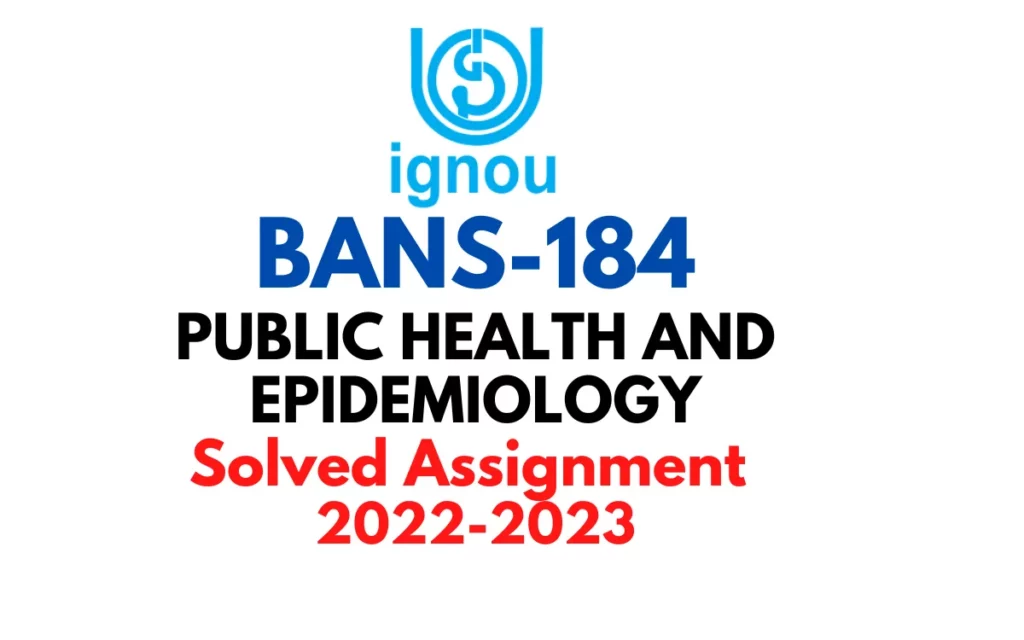Contents
BAG 184 Tourism Anthropology solved assignment for the academic year 2022-2023. This assignment is designed to test your understanding of the complex relationship between tourism and anthropology, and how it impacts the cultural, social, and economic aspects of host communities and the wider world. The assignment is based on the course material covered throughout the academic year and aims to assess your ability to critically analyze and evaluate the various topics discussed in class. We hope that this assignment will challenge you to think deeply about the impact of tourism and how it shapes our world. Good luck with your assignment!

| Title | BANS 184: PUBLIC HEALTH AND EPIDEMIOLOGY (BAG) Solved Assignment 2022-2023 |
| University | IGNOU |
| Degree | Bachelor Degree Programme (BAG) |
| Course Code | BANS 184 |
| Course Name | PUBLIC HEALTH AND EPIDEMIOLOGY |
| Year | 2023 |
| Language | English |
| Assignment Code | BANS 184/ASST/TMA |
Assignment – I
Answer the following in about 500 words each. 20X2= 40
a. What is Epidemiology? Briefly examine various categories of Observational studies.
Answer:
Epidemiology is a branch of medical science that deals with the study of the distribution and determinants of health-related states or events (including disease), and the application of this study to the control of health problems. Epidemiology helps to identify risk factors for disease and targets for preventive healthcare. It is an essential tool for public health practitioners, medical researchers, and policymakers. Epidemiology can be used to study the occurrence and spread of diseases in populations, identify risk factors and protective factors associated with specific diseases, evaluate the effectiveness of preventive and therapeutic interventions, and monitor the health status of populations over time.
There are several categories of observational studies in epidemiology, which include:
- Cohort studies: These are studies in which a group of individuals (the “cohort”) is followed over time, and the outcomes of interest are compared between subgroups within the cohort. Cohort studies are useful for studying the natural history of a disease, identifying risk factors for disease, and evaluating the effectiveness of interventions. They are considered the strongest type of observational study design and are often used to study rare diseases or long-term outcomes.
- Case-control studies: These are studies in which individuals with a specific outcome of interest (cases) are compared to individuals without the outcome (controls) with respect to prior exposure to a potential risk factor. Case-control studies are useful for studying rare diseases and diseases with long latency periods. They are also useful for identifying potential risk factors for a disease, but cannot establish causality.
- Cross-sectional studies: These are studies in which the prevalence of disease and the distribution of risk factors in a population are determined at a single point in time. Cross-sectional studies are useful for studying the distribution of a disease and risk factors in a population. They are often used to identify trends in disease over time and to identify high-risk groups.
- Ecological studies: These are studies that examine the relationship between a health outcome and an exposure of interest at the population level. Ecological studies are useful for identifying potential risk factors for a disease, but cannot establish causality. They are often used to identify trends in disease over time and to identify high-risk groups.
- Nested case-control studies: These are a type of case-control studies that are conducted within a defined cohort. Nested case-control studies are useful for studying rare diseases and diseases with long latency periods. They are also useful for identifying potential risk factors for a disease, but cannot establish causality.
- Retrospective cohort studies: These are a type of cohort studies that examines past exposures and health outcomes. Retrospective cohort studies are useful for studying rare diseases and diseases with long latency periods. They are also useful for identifying potential risk factors for a disease, but cannot establish causality.
b. Briefly discuss the core disciplines of Public Health.
Answer: Public health is a broad field that encompasses multiple disciplines, all working together to improve the health and well-being of populations. The core disciplines of public health include epidemiology, biostatistics, environmental health, health services administration, and health education and behavior.
Epidemiology is the study of the distribution and determinants of health-related states or events in specified populations, and the application of this study to control health problems. Epidemiologists use data to identify patterns of illness and injury in populations, and to understand the factors that contribute to these patterns. This information is then used to design and evaluate interventions that can improve health outcomes.
Biostatistics is the application of statistical methods to the study of health and disease. Biostatisticians use statistical techniques to analyze data and make inferences about health-related phenomena. They also design and conduct studies to test hypotheses and evaluate interventions.
Environmental health is the branch of public health that focuses on the impact of the physical, chemical, and biological environment on human health. Environmental health professionals work to identify and control environmental factors that can contribute to illness and injury, such as air and water pollution, exposure to hazardous chemicals, and inadequate sanitation.
Health services administration is the management and administration of public health programs and services. Health services administrators are responsible for planning, organizing, and directing the delivery of health care services. They also play an important role in developing and implementing policies and programs that can improve health outcomes.
Health education and behavior focuses on educating people about how to maintain good health and prevent disease. Health educators and behaviorists use a variety of strategies to promote healthy behaviors, such as developing educational materials, conducting health fairs, and working with community organizations.
All these core disciplines work together to identify and address public health issues, and to develop and implement effective interventions. They also use data and evidence-based approaches to monitor and evaluate the impact of these interventions on the health of populations.
Additionally, there are other disciplines that also contribute to Public Health such as:
- Social and Behavioral Sciences: which explore the social and psychological factors that influence health and illness, as well as the ways in which people make decisions about health-related behaviors.
- Health Economics: which study how economic factors influence the health of populations and how health-related policies and programs affect economic outcomes.
- Global Health: which focus on the health issues and concerns that transcend national boundaries, such as infectious diseases, non-communicable diseases, and health systems.
Assignment – II
Answer the following in about 250 words each. 10X3=30
a. National Health Programmes in India.
Answer:
India has several national health programs that aim to improve the health and well-being of its population. Some of the key programs include:
- National Health Mission (NHM): Launched in 2013, the NHM is a comprehensive program that aims to provide universal access to equitable, affordable, and quality healthcare services. It includes two sub-missions: the National Rural Health Mission (NRHM) and the National Urban Health Mission (NUHM). The NRHM focuses on providing healthcare services in rural areas, while the NUHM focuses on providing healthcare services in urban areas.
- National AYUSH Mission (NAM): Launched in 2014, the NAM aims to promote the use of Ayurveda, Yoga, Unani, Siddha and Homeopathy (AYUSH) systems of medicine. It aims to strengthen the infrastructure of AYUSH hospitals and dispensaries, and provide training to AYUSH practitioners.
- National Health Protection Scheme (NHPS): Launched in 2018, the NHPS aims to provide financial protection to poor and vulnerable families by providing them with health insurance coverage.
- National Programme for Prevention and Control of Cancer, Diabetes, Cardiovascular Diseases, and Stroke (NPCDCS): Launched in 2010, the NPCDCS aims to provide early detection and management of cancer, diabetes, cardiovascular diseases, and stroke. It includes screening, diagnosis, and treatment services.
- National Vector Borne Disease Control Programme (NVBDCP): Launched in 2003, the NVBDCP aims to control the spread of vector-borne diseases such as malaria, dengue, and chikungunya. It includes activities such as surveillance, vector control, and public education.
- National Mental Health Programme (NMHP): launched in 1982, the NMHP aims to provide mental healthcare services to the population. It includes activities such as training of healthcare workers, establishing mental health clinics, and raising awareness about mental health issues.
b. Discuss the role played by Government of India in the management of COVID19
Answer: The Government of India has played a significant role in the management of the COVID-19 pandemic, implementing a variety of measures to contain the spread of the virus and provide support to those affected by it.
One of the first measures taken by the government was to impose a nationwide lockdown in March 2020, which restricted movement and gatherings in an effort to slow the spread of the virus. This was followed by the implementation of several other measures such as the Aarogya Setu app, which allows people to self-assess their risk of infection, and the development of a dedicated COVID-19 website, which provides information and resources on the virus.
The government also set up a dedicated COVID-19 task force to coordinate the national response to the pandemic. This task force is responsible for monitoring the situation, providing guidance, and making recommendations on how to manage the outbreak.
In terms of healthcare, the government has taken several steps to increase the capacity of the healthcare system to deal with the pandemic. This includes the conversion of several facilities into dedicated COVID-19 hospitals, the procurement of personal protective equipment and other medical supplies, and the deployment of health workers to assist with the management of the outbreak.
Additionally, the government has also implemented a number of measures to support those affected by the pandemic, such as providing financial assistance to those who have lost their jobs, and providing food and shelter to those who have been displaced by the lockdown.
In terms of vaccination, the Government of India has launched the world’s largest vaccination drive. It has been using the Co-WIN platform for real-time monitoring of vaccine stocks and their distribution. The government has also been providing free vaccinations for certain groups of people and also has opened up the vaccination for all adults.
c. Discuss the impact of Globalisation on Human Health.
Answer:
Globalization has had a significant impact on human health, both positively and negatively. On the positive side, globalization has led to increased access to medical treatments, technology, and information, which has improved health outcomes for many people. The global market has enabled the spread of new treatments, drugs and vaccines, making them more accessible to people in developing countries. Globalization has also facilitated the sharing of knowledge and expertise among health professionals, which has led to the development of new and more effective treatments.
Globalization has also led to several negative impacts on human health. The increased movement of people and goods has led to the spread of infectious diseases, such as COVID-19 and the avian flu, across borders. Additionally, globalization has led to the spread of unhealthy lifestyle habits, such as poor diet and lack of physical activity, which have contributed to the rise in non-communicable diseases such as obesity, diabetes, and heart disease.
Globalization has led to the displacement of people and the disruption of traditional cultures, which has had negative impacts on mental health and well-being. Also, the increased trade and travel have facilitated the spread of environmental hazards such as pollution, which has had an impact on human health.
The economic and social inequalities that are associated with globalization have led to health disparities among different populations, with people in lower-income countries and marginalized communities being more likely to experience poor health outcomes.
Answer the following in about 150 words each. 5X6=30
a. Epidemic and Pandemic
Answer: An epidemic is an outbreak of a disease that occurs within a specific geographic area and affects a higher number of people than what is expected in that area. Epidemics can occur at the local, regional, or national level, and they typically involve a single disease. For example, an outbreak of the flu in a specific city or state would be considered an epidemic.
A pandemic, on the other hand, is an outbreak of a disease that affects a large number of people across the globe. A pandemic can be caused by a new strain of a virus or a previously unknown virus, and it typically results in widespread illness and death. The COVID-19 is an example of a pandemic.
b. Infectious Diseases
Answer:
Infectious diseases are illnesses caused by the presence of microorganisms such as bacteria, viruses, fungi, or parasites in the body. These microorganisms can be transmitted from person to person, through contact with contaminated surfaces or objects, through exposure to infected animals, or through exposure to contaminated food or water.
Examples of infectious diseases include the flu, tuberculosis, HIV/AIDS, measles, and malaria. Some infectious diseases can be treated with antibiotics, while others can only be managed with supportive care. Some infectious diseases such as COVID-19 can be prevented through vaccination.
Infectious diseases can have a significant impact on public health, leading to illness, disability, and death. They can also lead to economic and social disruptions, as outbreaks can lead to school closures, travel restrictions, and other measures. Therefore, it is important to take steps to prevent and control the spread of infectious diseases, such as through vaccination, good hygiene practices, and public health surveillance.
c. Random sampling
Answer: Random sampling is a statistical method in which a sample of individuals or observations is chosen from a larger population in such a way that every member of the population has an equal chance of being selected. This method of sampling is used to make inferences about a population based on the characteristics of the sample.
One way to achieve random sampling is through simple random sampling, in which every member of the population is assigned a unique number and then a number is generated randomly to select the individuals for the sample. Another way is through systematic sampling, in which every nth individual is selected from a list of the population.
Random sampling helps to ensure that the sample is representative of the population and eliminates bias in the selection process. It also makes it possible to estimate the level of uncertainty in the sample statistics. Therefore, random sampling is considered a more accurate way of obtaining a sample compared to other methods such as convenience sampling, where the sample is chosen based on accessibility.
d. Environmental Health
Answer: Environmental health is the branch of public health that focuses on the impact of the environment on human health. This includes studying the effects of physical, chemical, and biological agents in the environment on health, as well as the impact of human activities on the environment.
Examples of environmental health concerns include air pollution, water pollution, exposure to hazardous chemicals, and climate change. These factors can lead to a range of health problems, such as respiratory illness, cancer, and cardiovascular disease. Environmental health also includes studying the impact of built environments, such as housing and urban design, on health and well-being.
To address environmental health concerns, public health practitioners work to identify and reduce exposure to harmful agents in the environment, as well as promoting policies and practices that support healthy environments. This may include monitoring and regulating air and water quality, promoting sustainable development, and educating the public about the importance of protecting the environment for health.
e. χ² test
Answer: The chi-squared (χ²) test is a statistical test used to determine if there is a significant difference between the observed frequencies in a sample and the expected frequencies in a population. It is commonly used in the field of statistics to test the goodness of fit of a hypothesis to the observed data and to test the independence of two categorical variables.
The chi-squared test is used to compare the observed frequencies in a sample to the expected frequencies in a population. The test statistic is calculated by summing the squared differences between the observed and expected frequencies, divided by the expected frequencies. The test statistic is then compared to a chi-squared distribution to determine the probability that the difference between the observed and expected frequencies is due to chance.
The chi-squared test is a useful tool for analyzing categorical data and can be used to test hypotheses about a wide range of phenomena, including the distribution of categories in a sample, the relationship between two categorical variables, and the difference between two groups.
f. Gender and Health
Answer:
Gender and health refers to the ways in which gender roles, identities, and relations influence health and healthcare experiences. Gender is a social construct that refers to the expectations, roles, and behaviors assigned to individuals based on their perceived sex.
Research has shown that there are significant health disparities between men and women, with women often experiencing worse health outcomes. For example, women are at a higher risk of certain health conditions such as osteoporosis and autoimmune diseases, and are also more likely to experience mental health issues such as depression and anxiety. Additionally, women may face barriers to accessing healthcare, such as poverty or lack of education.
Gender also plays a role in shaping healthcare experiences. For example, research has shown that women are less likely to receive the same level of pain management as men, and that they may be more likely to be dismissed when they report symptoms.
To address these disparities, it is important to take a gender-sensitive approach to healthcare, which considers the ways in which gender influences health and healthcare experiences. This may include providing gender-specific health education and services, and training healthcare providers to recognize and address gender-based barriers to care.
FAQs
What is the format of the BANS 184: Tourism Anthropology (BAG) assignment?
The format of the assignment will be provided by the instructor, but it typically includes a combination of research and analysis of tourism-related topics, readings, and case studies.
When is the deadline for submitting the BANS 184: Tourism Anthropology (BAG) assignment?
The deadline for submitting the assignment will be provided by the instructor.
How can I get help with the BANS 184: Tourism Anthropology (BAG) assignment?
You can get help with the assignment by discussing it with your instructor, visiting the Edukar.in website.









![[Solved Assignment] BPCS 188-APPLICATIONS OF SOCIAL PSYCHOLOGY (IGNOU-BAG) 2022-2023 BPCS 188-APPLICATIONS OF SOCIAL PSYCHOLOGY IGNOU BAG Solved Assignment 2022-2023](https://edukar.org/wp-content/uploads/2023/01/BPCS-188-APPLICATIONS-OF-SOCIAL-PSYCHOLOGY-IGNOU-BAG-Solved-Assignment-2022-2023-1024x640.webp)





